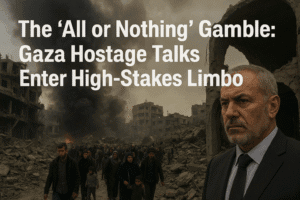The “All or Nothing” Gamble: Gaza Hostage Talks Enter High-Stakes Limbo
Netanyahu has abandoned phased hostage talks, demanding Hamas release all remaining captives (approx. 50, 20 believed alive) “in one go.” This hardline shift follows failed negotiations, with Israel accusing Hamas of bad faith. Meanwhile, Gaza faces intensified bombardment – over 123 Palestinians killed recently – and famine deepens as UN reports record starvation. Mediators scramble amidst clashing demands: Israel insists on Hamas’ surrender and control over Gaza, while Hamas demands a full Israeli withdrawal and statehood guarantees.
Hostage families warn expanded military operations endanger captives, while Netanyahu’s suggestion of Palestinian “voluntary” emigration fuels historical displacement fears. With Israel planning a major Gaza offensive by October and both sides entrenched, civilians remain trapped between escalating violence and collapsing diplomacy – prolonging collective suffering with no clear path to resolution.

The “All or Nothing” Gamble: Gaza Hostage Talks Enter High-Stakes Limbo
Why Netanyahu’s Shift to Demanding All Hostages at Once Risks Lives and Prolongs War
The Core Shift
Israel’s Prime Minister Benjamin Netanyahu has abruptly abandoned phased ceasefire talks, declaring future negotiations must secure all remaining hostages “in one go” – alive or dead. This hardline pivot comes after months of failed incremental deals, with Netanyahu accusing Hamas of “misleading” mediators. The move signals a dangerous stalemate: Israel now demands total victory, while Hamas insists on a permanent ceasefire and full Israeli withdrawal as non-negotiable terms.
The Human Toll Beneath the Rhetoric
- Hostage Families’ Agony: Relatives of the 50 captives (20 believed alive) face renewed despair. Families warn expanded military operations in Gaza City’s Zaytoun district – where Israel just launched new raids – directly endanger hostages. “Abandoning talks means abandoning our loved ones,” protests one mother.
- Gaza’s Unseen Crisis: As talks stall, Israeli strikes killed 123 Palestinians in 24 hours alone. Seven family members, including five children, died when tents were hit in Tel al-Hawa. The UN confirms famine is accelerating, with 235+ dead from starvation – 106 being children.
Why “All at Once” Is a High-Risk Strategy
- Military vs. Diplomatic Timelines: Israel plans a full-scale assault on Gaza by October, leaving weeks for diplomacy. Netanyahu bets overwhelming force will pressure Hamas, but history shows urban warfare imperils hostages.
- The Displacement Wildcard: Netanyahu’s call for Palestinians to leave Gaza “voluntarily” echoes traumatic historical displacement fears (“Nakba”). This undermines regional cooperation critical for any deal.
- Mediators in Disarray: Egypt pushes to revive the original 60-day truce plan, while Hamas demands statehood guarantees. The U.S. and Qatar now scramble to bridge irreconcilable demands.
What Neither Side Admits
- Netanyahu’s Domestic Bind: His coalition relies on far-right parties opposing any deal. Hostage families’ protests grow, yet expanding the war delays his political reckoning.
- Hamas’ Calculated Cruelty: Holding hostages remains its sole leverage. Rejecting partial releases traps civilians in crossfire while it regroups in rubble.
The Path from Here
A comprehensive deal remains unlikely without unprecedented concessions: Israel accepting Hamas’ survival or Hamas surrendering its weapons. With both sides entrenched, the grim reality is that:
- Civilians pay the highest price as famine spreads
- Hostage fates grow more uncertain
- Regional escalation risks deepen
The tragedy isn’t just the failure of talks – it’s that “all or nothing” may ultimately mean nothing for hostages, Palestinians, and lasting security.
You must be logged in to post a comment.